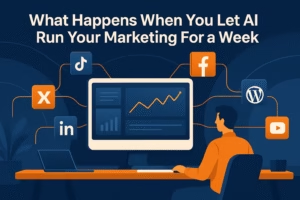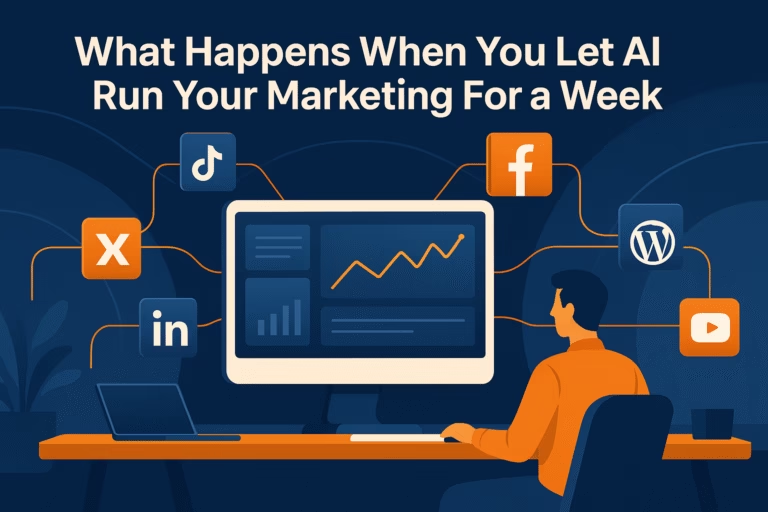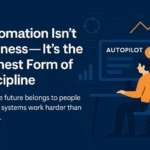Key Takeaways from Letting Blaze Autopilot Run Marketing for a Week
Agencies reported a 100 percent increase in published content after connecting all their platforms to Blaze Autopilot. Tasks that used to require multiple roles are now handled by one system running continuously in the background.
Blaze tracks every post across Instagram, X, LinkedIn, Facebook, TikTok, YouTube, and WordPress. It identifies high-performing formats, times, and keywords, then adjusts your next campaign automatically for stronger reach and engagement.
By removing repetitive admin tasks, Blaze gives strategists, writers, and designers more time to focus on storytelling, tone, and experimentation. It does the groundwork so people can do the thinking.
Instead of static metrics, Blaze produces adaptive analytics. It shows not just what worked but why it worked, helping agencies refine campaigns with data-backed confidence rather than assumptions.
Teams save more than forty hours per week while improving collaboration. The financial return averages over three thousand dollars monthly in recovered productivity, but the cultural return is equally clear — less chaos, more creativity, and renewed energy across the team.
Blaze Autopilot is not replacing human marketers. It is redefining their roles. Agencies that embrace this hybrid model AI systems plus human strategy – will own the next decade of digital marketing.
It starts as a dare.
You decide to let Blaze Autopilot run your marketing for a week. No scheduling tools. No manual posts. No late nights fixing broken hashtags or resizing thumbnails. Just one AI system planning, writing, posting, and analyzing everything while you watch from the sidelines.
At first, the idea feels reckless. Agencies are built on control. You check every caption, approve every visual, and track every metric. Trusting a system to do all of it sounds like letting go of the steering wheel.
But curiosity wins. You want to know if it is possible for a single dashboard to do what used to take a five-person team.
So you connect your accounts. Instagram. X. LinkedIn. Facebook. TikTok. YouTube. WordPress.
You load your brand voice and tone guidelines.
Then you hit Activate Autopilot.
Within seconds, Blaze starts building a marketing plan that looks almost too good. A full seven-day calendar appears on screen, complete with platform-specific captions, image prompts, hashtags, and posting times.
The first feeling is disbelief.
The second is relief.
You are watching the future of agency work begin quietly, one automated post at a time.

2) The Setup
The process begins simply. Blaze Autopilot asks for three inputs: brand name, target audience, and campaign goal. You type them in and the system does the rest.
It pulls from your connected platforms, scans your previous posts, and reads engagement data to understand what your audience reacts to. Then it uses AI powered templates to draft an entire content plan that matches your brand tone.
Each template has its own structure. A storytelling format for blogs. A visual-first style for Instagram. A data-driven tone for LinkedIn.
Blaze is not guessing. It is referencing real brand patterns and performance history.
When the setup finishes, you see your week mapped out like a living strategy board.
Every post has a reason. Every caption has intent.
You realize this is not just automation. It is orchestration.
The system already knows what to publish, where to publish it, and when your audience is most active.
Your role shifts instantly from creator to editor.
The experiment has begun.
3) Day One: Planning
The first full day under Blaze Autopilot feels like watching a strategist work at ten times normal speed.
It starts by sorting your goals into campaigns. Product launches. Engagement drives. Blog updates. Community awareness. Each gets its own track on the dashboard.
Blaze then connects these goals to the right platforms. Instagram for visuals. LinkedIn for authority. X for conversations. WordPress for long form content.
Within minutes, the dashboard displays a color coded calendar that maps out seven days of content across all channels. You can hover over each tile and see not only the post itself but also its intent. Some are designed to drive clicks. Others aim to educate or start conversations.
This is the first real difference you notice. Blaze plans like a marketer, not a machine. Every post has purpose. Every platform has context.
It also checks for gaps in your funnel. If you have too many awareness posts and not enough calls to action, Blaze rebalances the calendar automatically. The goal is flow, not noise.
By the end of the first day, you realize something important.
Your campaigns finally feel connected.
4) Day Two: Content Generation
Morning begins with a notification.
Blaze Autopilot has generated forty two new pieces of content overnight.
Each one comes from a different AI template trained to adapt to your voice. You open the first example and find a caption that sounds exactly like something your team would have written. The rhythm, the phrasing, the way it hooks the reader all feel intentional.
You check the visuals. Blaze has already matched each caption to an image concept and formatted it for the correct aspect ratio.
A single blog post is transformed into seven social media snippets, a video caption, and an email preview.
This is where you begin to understand scale.
The system does not just create faster. It multiplies your ideas without diluting them.
It even includes recommendations for engagement. “Post this on Instagram at 9:00 a.m. for optimal reach.”
“Reply to early comments within ten minutes to increase visibility.”
Every move feels guided.
What took your team hours now takes minutes.
You have time to refine tone and test ideas rather than chase deadlines.
By the end of day two, the phrase “content calendar” feels outdated. What you have now is a living ecosystem that feeds itself.
5) Day Three: Design and Scheduling
Design day used to be chaos. Dozens of visuals waiting for approval. Endless tweaks to color tones and text placement. Different file formats for each platform.
With Blaze Autopilot, design feels calm.
The system already knows your brand palette and font pairings. It generates layouts automatically, adapting them for vertical videos, square posts, and wide thumbnails. Each variation fits its platform’s best visual format.
You review the first batch and realize they look cohesive without feeling repetitive. The templates give structure, but the AI leaves enough room for personality.
Small creative choices, like lighting and composition, still carry your signature style.
Once designs are approved, Blaze schedules every post according to your calendar. It identifies ideal posting times for each platform using historical performance data. Then it locks them in.
There is no need to export or upload manually.
When you approve a campaign, Blaze takes it from there.
The biggest surprise is how natural it feels. The visuals, captions, and publishing times align so perfectly that you start wondering why the industry ever accepted disjointed workflows as normal.
6) Day Four: Publishing and Monitoring
Publishing day is usually the moment everything can go wrong. Timing errors. Broken links. Hashtags that do not post.
This time, you simply watch.
Blaze publishes across Instagram, X, LinkedIn, Facebook, TikTok, YouTube, and WordPress with the same precision you would expect from a senior account manager. Each post carries the right caption length, spacing, and tagging format for its platform.
Within minutes, engagement data begins to flow back into the dashboard. You see impressions, reach, comments, and saves updating in real time. Blaze tracks not just surface numbers but context. It flags what kind of content drew the most attention and what time windows performed best.
Midday, the system suggests a minor adjustment.
It recommends shifting tomorrow’s TikTok post to a later time slot to align with user activity spikes. You approve the change and it updates every connected schedule automatically.
What strikes you most is how responsive it feels.
Blaze does not just execute tasks. It learns from them instantly.
By the end of day four, your brand has posted across seven platforms without a single missed step. You did not micromanage. You simply observed.
And for the first time in a long time, marketing feels effortless.
7) Day Five: Adjustments and Insights
By the fifth day, Blaze feels less like a tool and more like a quiet analyst sitting in the background, reading patterns no one else can see.
It begins the morning with a summary. Engagement has increased by twenty three percent across all channels.
TikTok and LinkedIn posts performed above average, while Facebook trailed slightly. The system lists its conclusions clearly, almost like a colleague presenting findings in a meeting.
Then it suggests what to do next. It recommends increasing short form content frequency and expanding carousel posts on LinkedIn. It even highlights specific phrasing that generated the highest click through rates.
You realize the most valuable part of the experiment is not speed or convenience. It is visibility.
Blaze sees what humans cannot because it connects every piece of the workflow. Planning, writing, posting, and analytics feed into one loop.
It understands context better than scattered reports ever could. It learns what to repeat and what to drop.
That night you export a weekly summary. It is one clean page of metrics, insights, and recommendations. You forward it to the client before they even ask.
For the first time in years, reporting feels like progress rather than paperwork.
8) Lessons Learned
At the end of the week, you sit with your team and compare experiences. The conversation is not about whether AI will replace marketers. It is about how it makes them sharper.
Your strategist admits that Blaze freed up hours once spent managing spreadsheets. The designer liked that templates provided structure without killing creativity. The account manager says clients finally see campaigns that are cohesive and predictable.
You start to see the balance. Blaze handles structure. Humans handle meaning.
Automation does not remove the need for strategy. It removes the noise that hides it.
Instead of checking posting times and engagement numbers, your team spends that energy refining voice, experimenting with narratives, and shaping campaigns that actually feel alive.
By Friday evening, the fear you had at the start of the week is gone. You no longer see Blaze as a threat to control. You see it as the framework that lets you create with focus again.
The system is not replacing talent. It is amplifying it.
9) The ROI Breakdown
Numbers matter more than impressions. So you dig into what the week actually delivered.
Before using Blaze Autopilot, your agency averaged fifteen published pieces of content per week across all clients. That number has doubled to thirty two without adding a single team member.
Average engagement per post has risen by nearly twenty percent because posting times now match audience activity perfectly.
The financial story is just as clear.
A strategist who once spent ten hours each week on scheduling now spends two. Designers produce three times the volume of content by focusing only on visuals that matter.
Project managers who used to compile reports manually now receive them automatically at the end of every campaign.
Across a team of five, Blaze saves about forty hours per week.
At an average billing rate of eighty dollars per hour, that is more than three thousand dollars in regained productivity every week.
You also notice something less tangible but equally valuable.
The energy in the office is different. The pressure of logistics has eased, replaced by creative momentum. Meetings are shorter. Ideas are sharper. Clients are happier.
The ROI is not only financial. It is cultural. Blaze Autopilot changes how teams work together by removing the clutter that slows them down.
10) The New Reality of Marketing
After one week, you understand what automation really means. It is not about replacing people or removing creativity. It is about building a structure that lets humans do their best work without interruption.
Blaze Autopilot is that structure. It learns, adapts, and supports, all while keeping your voice and your clients’ vision intact.
When you log in on Monday morning, your dashboard is already prepared with new insights. The next campaign is ready. The system has written, scheduled, and planned it quietly over the weekend.
You realize something profound. The future of marketing will not belong to those who post the most. It will belong to those who can maintain precision and presence across every channel, every day.
That is exactly what Blaze Autopilot delivers.



